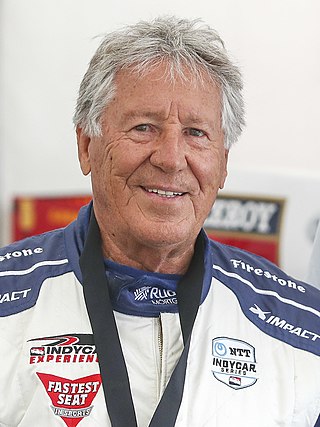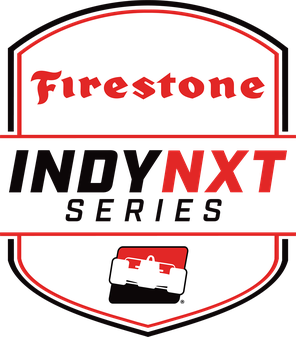
Mario Gabriele Andretti is an American former racing driver and businessman, who competed in Formula One from 1968 to 1982, and IndyCar from 1964 to 1994. Andretti won the Formula One World Drivers' Championship in 1978 with Lotus, and won 12 Grands Prix across 14 seasons. In American open-wheel racing, Andretti won four IndyCar National Championship titles and the Indianapolis 500 in 1969; in stock car racing, he won the Daytona 500 in 1967. In endurance racing, Andretti is a three-time winner of the 12 Hours of Sebring.

Alfred Unser was an American automobile racing driver, the younger brother of fellow racing drivers Jerry and Bobby Unser, and father of Al Unser Jr. He was the second of four men to have won the Indianapolis 500 four times, the fourth of six to have won the race in consecutive years, and the winner of the National Championship in 1970, 1983, and 1985. The Unser family has won the Indy 500 a record nine times. He was the only person to have both a sibling (Bobby) and child as fellow Indy 500 winners. Al's nephews Johnny and Robby Unser have also competed in that race. In 1971, he became the only driver to date to win the race on his birthday.

Robert William Unser was an American automobile racer. At his induction into the Motorsports Hall of Fame of America in 1994, he had the fourth most IndyCar Series wins at 35. Unser won the 1968 and 1974 United States Automobile Club (USAC) national championships. He won the Pikes Peak International Hill Climb overall title 10 times.

The DFV is an internal combustion engine that was originally produced by Cosworth for Formula One motor racing. The name is an abbreviation of Double Four Valve, the engine being a V8 development of the earlier four-cylinder FVA, which had four valves per cylinder.

Danny Ongais was an American racing driver.

Rufus Parnell "Parnelli" Jones was an American professional racing driver and racing team owner. He is notable for his accomplishments while competing in the Indianapolis 500 and the Baja 1000 desert race, and the Trans-Am Championship series. In 1962, he became the first driver to qualify over 150 mph (240 km/h). He won the race in 1963, then famously broke down while leading the 1967 race with three laps to go in a turbine car. During his career as an owner, he won the Indy 500 in 1970–1971 with driver Al Unser.
Chaparral Cars was a pioneering American automobile racing team and race car developer that engineered, built, and raced cars from 1963 through 1970. Founded in 1962 by American Formula One racers Hap Sharp and Jim Hall, it was named after the roadrunner, a fast-running ground cuckoo also known as a chaparral bird.

Indy NXT, previously Indy Lights, is an American developmental automobile racing series sanctioned by IndyCar, currently known as INDY NXT by Firestone for sponsorship reasons. Indy NXT is the highest step on the Road to Indy, a program of racing series leading up to the IndyCar Series.

Patrick Racing was an auto racing team in USAC, CART, Champ Car and the Indy Racing League. Patrick Racing was started by U.E. "Pat" Patrick in the 1970s. The team is best known for winning the Indianapolis 500 on three occasions, and the Indy car title twice. Patrick Racing achieved 45 Indy car wins.
This article discusses the year-by-year history of the Indianapolis 500 race.

The 78th Indianapolis 500 was held at the Indianapolis Motor Speedway in Speedway, Indiana on Sunday, May 29, 1994. The race was sanctioned by United States Auto Club (USAC), and was included as race number 4 of 16 of the 1994 PPG IndyCar World Series. For the second year in a row, weather was not a factor during the month. Only one practice day was lost to rain, and pole day was only partially halted due to scattered showers. Warm, sunny skies greeted race day. Al Unser Jr. won the race from the pole position, his second of two Indy 500 victories.

The 71st Indianapolis 500 was held at the Indianapolis Motor Speedway in Speedway, Indiana, on Sunday May 24, 1987. After dominating practice, qualifying, and most of the race, leader Mario Andretti slowed with mechanical problems with only 23 laps to go. Five laps later, Al Unser Sr. assumed the lead, and won his record-tying fourth Indianapolis 500 victory. At age 47, just days short of his 48th birthday, Unser became the oldest winner of the Indy 500, a record that still stands as of 2024. During the month of May, an unusually high 25 crashes occurred during practice and qualifying, with one driver in particular, Jim Crawford, suffering serious leg injuries.
Joseph Paul Leonard was an American professional motorcycle racer and racecar driver.

The 1980 CART PPG Indy Car World Series season was the second in the CART era of U.S. open-wheel racing. It consisted of twelve races, beginning in Ontario, California on April 13 and concluding in Avondale, Arizona on November 8. The PPG Indy Car World Series Drivers' Champion and Indianapolis 500 winner was Johnny Rutherford. Rookie of the Year was Dennis Firestone. The entire season, including the 64th Indianapolis 500, was to be co-sanctioned by both the USAC and CART under the banner of the Championship Racing League (CRL). However, USAC withdrew from the arrangement after five races.
The Parnelli VPJ4 was a Formula One racing car designed by Maurice Philippe, and used by Vel's Parnelli Jones Racing during the 1974, 1975 and 1976 Formula One seasons.

The Penske PC-10 is a CART open-wheel race car, designed by Penske Racing, which was constructed for competition in the 1982 season. Designed by Geoff Ferris, it is considered possibly the most dominant Penske race car design ever and that from a team that typically dominated. Rick Mears has been quoted as acknowledging this was his favorite racecar chassis ever. Twelve total were made (1-12), six raced by Penske (1-6), with four confirmed destroyed. They were manufactured at Penske Cars, Ltd. in Poole, England during 1982, and delivered to Penske Racing, Inc., in Reading, Pennsylvania. So outstanding was the PC-10's design, it won the prestigious Louis Schwitzer Award for innovation and engineering excellence in the field of race car design at the Indianapolis 500 in 1982. The PC-10s were active in the years 1982–1984. In fact, the PC-10 was ultimately much better than the following year PC-11, so Roger Penske bought back one of the PC-10s he had sold to another team for the 1983 season, and which then won another race for his team.

The Ford-Cosworth Indy V8 engine is a series of mechanically similar, turbocharged, 2.65-liter V-8 engines, designed and developed by Ford in partnership with Cosworth for use in American open-wheel racing. It was produced for over 30 years and was used in the United States Auto Club (USAC) Championship Car series, CART, and Champ Car World Series between 1976 and 2007. The DFX engine was the Indy car version of the highly successful 3-liter Ford-Cosworth DFV Formula One engine developed by former Lotus engineer Keith Duckworth and Colin Chapman backing from Ford for the Lotus 49 to campaign the 1967 season. This engine had 155 wins between 1967 and 1985 in F1. The DFX variant was initially developed for Indy car use by Parnelli Jones in 1976, with Cosworth soon taking over. This engine won the Indianapolis 500 ten consecutive years from 1978 to 1987, as well as winning all USAC and CART championships between 1977 and 1987. It powered 81 consecutive Indy car victories from 1981 to 1986, with 153 Indy car victories total.
The Parnelli VPJ6 is an open-wheel race car, designed by British designer John Barnard for Vel's Parnelli Jones Racing, to compete in U.S.A.C. Championship Car, between 1975 and 1980, as well as in CART, between 1979 and 1980. It was driven by Danny Ongais, Al Unser, George Snider, Bill Whittington, Lee Kunzman, and A. J. Foyt. It notably gave Foyt his last IndyCar championship, in 1979. It was powered by the powerful and successful DFV-derived DFX.
The Parnelli VPJ2 is an open-wheel race car, designed by British designer and engineer Maurice Phillippe for Vel's Parnelli Jones Racing, to compete in U.S.A.C. Championship Car, between 1973 and 1974. It was driven by Jan Opperman, Mario Andretti, and Al Unser. It was powered by an Offenhauser four-cylinder turbo engine, reputed to develop between 800–1,300 hp (600–970 kW), depending on turbo boost pressure levels. It won two races; one for Unser at Texas, and one for Andretti at Trenton.

The Parnelli VPJ1 is an open-wheel race car, designed by British designer and engineer Maurice Phillippe for Vel's Parnelli Jones Racing, to compete in U.S.A.C. Championship Car for 1972. It was driven by Mario Andretti, Al Unser, and Joe Leonard. It was powered by an Offenhauser four-cylinder turbo engine, reputed to develop between 1,200–1,300 hp (890–970 kW), depending on turbo boost pressure levels. In its original configuration, the car was designed with dihedral wings mounted to either side of the cockpit and sticking up at 45-degree angles. However, the unusual aerodynamic design proved no performance benefits, and by the Indianapolis 500 in May, the design had been revised to have the wings removed. Following the redesign, the car saw success, most notably with Joe Leonard who won three races and won the 1972 USAC Championship. Al Unser and Mario Andretti saw minor achievements, with Unser scoring podiums at Indianapolis and Pocono, and Andretti at Phoenix.













